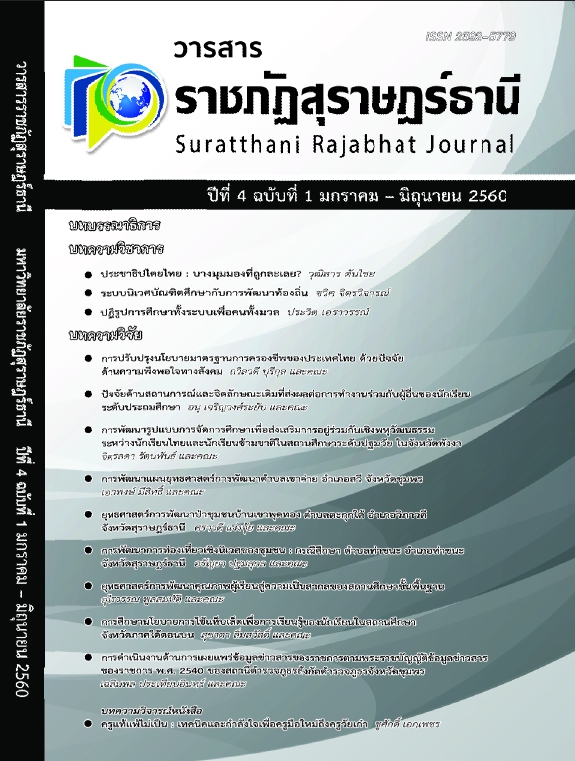The Development of Community Ecotourism: A Case Study of Thachana Sub-District, Thachana District, Surat Thani Province
Main Article Content
Abstract
The purposes of this research were to study the community context, problems and needs developing ecotourism and building strategy on ecotourism development of community of Tha Chana Sub-district, Tha Chana District, Surat Thani Province. Samples used in this study were both formal leaders and informal leaders, accommodation entrepreneurs and those concerned, public sector representatives and people in community with amount of 50 people. Research methodologies were document analysis, in-depth interview, focus group and workshop by using SWOT Analysis technique.
The results found that community context of Tha Chana Sub-district were the gate to Surat Thani Province with characteristics as rural society with way of life affiliating with the natures. They earned a living for agriculture such as gardening rubber trees, oil palm and coastal fisheries. There were the roads connecting with both areas of central district and province. Transportation and public utility systems were in excellent condition. Most areas were low plain, some parts as mountains and having areas connecting to the coast of Thai Gulf with the beaches to be proper with tourism activities, namely, Hat Samrej, Hat Paknamthakrajai, Hat Nang Loy and Khao Prasong Cave. Ecotourism problems were thatpeople in community still lackedknowledge, cooperation and thinking leaders on activities relating to ecotourism, needs for tourism development from public sectors on budget to support in order to reform tourism activity, public relations, layout poster telling various places, providing the knowledge with training local guides including sources distributing products from folk wisdom. It was found thatthere were four strategies gaining from building strategy for developing ecotourism of community which were 1) SO strategy that were tourism development, promoting religions, arts and cultures, community and society organizations and public order, building confidence and promoting tourism activity, developing products of folk wisdom, 2) ST strategy which aimed to develop and restore sustainable tourist attractions, 3) WO strategy which aimed to reinforce tourism activity, and 4) WT strategy which was about infrastructure and facilities development for tourism.
Article Details
References
จตุพล ชูจันทร์. (2553). การพัฒนากลยุทธ์ในการบริหารจัดการเพื่อการท่องเที่ยวยั่งยืน ตำบลบ้านใต้ อำเภอเกาะพงัน จังหวัดสุราษฎร์ธานี. วิทยานิพนธ์ปรัชญาดุษฏีบัณฑิต สาขายุทธศาสตร์การพัฒนา บัณฑิตวิทยาลัย มหาวิทยาลัยราชภัฏพระนคร.
มัชฌิมา อุดมศิลป์. (2555). แนวทางการส่งเสริมการท่องเที่ยวเชิงนิเวศ เพื่อการพัฒนาที่ยั่งยืนของชุมชนคลองโคลน จ.สมุทรสงคราม. วิทยานิพนธ์ศิลปศาสตรมหาบัณฑิต สาขาวิชาพัฒนศึกษา บัณฑิตวิทยาลัย มหาวิทยาลัยศิลปากร
สมบุญ แสงฉาย. (2554). ประวัติศาสตร์ท้องถิ่นท่าชนะ. สุราษฎร์ธานี : โครงการจัดการความรู้ภูมิปัญญาท้องถิ่น
สุชน อินทเสม. (2554). ยุทธศาสตร์การพัฒนาการท่องเที่ยวแบบยั่งยืนจังหวัดประจวบคีรีขันธ์ : กรณีศึกษาตำบลปากน้ำปราณ. วิทยานิพนธ์ปรัชญาดุษฎีบัณฑิต สาขาวิชายุทธศาสตร์การพัฒนา บัณฑิตวิทยาลัย มหาวิทยาลัยราชภัฏพระนคร.
สำนักงานจังหวัดสุราษฎร์ธานี. (2553). ยุทธศาสตร์การพัฒนาจังหวัดสุราษฎร์ธานี แบบบูรณาการ. สุราษฎร์ธานี : คณะกรรมการบริหารจังหวัดแบบบูรณาการจังหวัดสุราษฎร์ธานี


